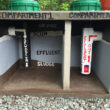The Pingtang Bridge in Guizhou, China, stands as a stunning example of engineering innovation and progress. Boasting the largest concrete tower in the world, this architectural wonder is not just a bridge—it is a lifeline that connects communities, accelerates travel, and drives economic development in one of China’s most challenging terrains.

A Record-Breaking Structure
The Pingtang Bridge spans an impressive 2,135 meters, crossing a vast canyon to serve as a critical connection point for the Pingtang-Luodian highway. At the heart of this bridge lies its record-breaking concrete tower, a feat of design and construction that has drawn global admiration.
Engineering Feat and Construction
The bridge was constructed at a cost of 1.5 billion yuan (approximately 215 million dollars), a substantial investment in infrastructure for the region. Its design and construction were tailored to overcome the geographical challenges of Guizhou, a province known for its rugged, rocky, and desertified landscapes.
The bridge not only meets the demands of modern transportation but also demonstrates China’s prowess in civil engineering, blending strength, durability, and aesthetics.
Transforming Travel
Before the Pingtang Bridge, the journey between Pingtang and Luodian required over two and a half hours of travel through winding roads and challenging terrain. With the commissioning of this bridge, that travel time has been dramatically reduced to just one hour. This improvement enhances connectivity and accessibility for residents and travelers alike.
Economic and Social Impact
The Pingtang Bridge is more than an infrastructure project; it is a catalyst for economic growth and poverty alleviation. By linking Guizhou to neighboring provinces such as Yunnan and the Guangxi Zhuang Autonomous Region, the bridge facilitates trade, tourism, and regional integration.
This enhanced connectivity brings new opportunities to areas previously isolated by geographical barriers. The bridge is expected to play a crucial role in reducing poverty in these regions, providing access to resources, markets, and essential services.

A Symbol of Progress
The Pingtang Bridge reflects China’s commitment to developing its western regions, which have historically lagged behind the eastern provinces. It embodies the potential of modern engineering to transform lives and landscapes, bridging not just physical gaps but economic and social divides.
Conclusion
The Pingtang Bridge in Guizhou is a triumph of engineering and a beacon of hope for the region. Its towering concrete structure and far-reaching impact symbolize progress, connectivity, and opportunity. As it shortens travel times and enhances regional integration, the bridge stands as a testament to the power of infrastructure to drive development and uplift communities.


















